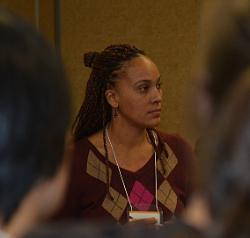This section of the SUNY Empire website is no longer being updated.
View current SUNY Empire Stories.
November 4, 2015
Faculty Introduced to Learnscape, an Open Educational Resource, at Academic Conference
 Rhianna Rogers (left), assistant professor of Cultural Studies, and Nathan Whitley-Grassi, educational technologist, shared with colleagues at the Academic Conference, held Oct. 28-30, a new resource the college is offering for faculty: Learnscape.
Rhianna Rogers (left), assistant professor of Cultural Studies, and Nathan Whitley-Grassi, educational technologist, shared with colleagues at the Academic Conference, held Oct. 28-30, a new resource the college is offering for faculty: Learnscape.
Rogers, who describes herself as an “early adapter” of open educational resources, showed how a number of apps, like Photosynth and Screencast, could be folded into Learnscape, an audio-video sharing system, to create richer learning experiences for Empire State College students.
Learnscape is more efficient for faculty, Whitley-Grassi said, because it can be accessed via college login and reached through Moodle. It is a good way “to enhance your courses with video resources,” he said. In contrast to Youtube, which belongs to someone else and can be deleted or possibly not accessible for the disabled, videos uploaded into Learnscape are faculty resources that can be returned to again and again. Learnscape also has a closed-caption editor so that, once captions are input by voice and formulated by the computer, faculty can edit them. Whitley-Grassi estimated the computer-generated captioning to be 80 percent accurate. He cautioned that faculty should acquire “a decent web cam and mic” to record captions.
Videos on Learnscape also are searchable, and students can download and print transcripts. Rogers said she can introduce herself via video to her students and they can discuss papers with track changes in real time. She also has, in the past, taken advantage of 3D imaging software to examine artifacts.
Rogers recently returned from a sabbatical, where she worked with 15 colleagues on developing open educational resources. She was using a number of different independent apps prior to this (she referred people to her open education resource listing at her college Commons page), but now, all of her information has transitioned to Learnscape. For example, students in one of her courses on Columbus can take a video tour of the site where he landed and see an interview with an archeologist, “enhancing the way students are interacting with my course.” She also integrates introductory remarks, the course syllabus and other resources in her videos. She views analytics and surveys her students see if they are using the resources and if they are useful.
In developing open educational resource content, she recommended working with an educational technologist to determine a timeframe, as well as a learning objective stating how the resource will enhance the course, developing documentation and the ways faculty want to be interactive (hotspots for maps or voice explanations, for example). Also, she cautioned faculty to leave time for revisions. When shooting video of oneself for students, she said, one needs “to think about the background: take down those crazy cat pictures,” for example.
Faculty should also ensure that outside apps they’d like to use are supported by the technology at the college. She said bandwidth has not been a big issue with most students, and, if it is, she can always provide them with an mp4 file.
“Adapting this technology has been one of the biggest lifesavers for me. I have put it through all of my courses,” she said.